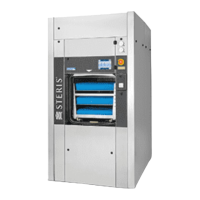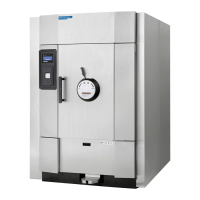5-5
Component Identification Operator Manual 129390199
5.5 Alarm Displays Alarm displays tell operators and technicians when the sterilizer is
experiencing an abnormal condition. Alarm conditions can be
caused by failure of utility supplies or sterilizer components.
S
ECTION 9, TROUBLESHOOTING, details the steps an operator can take
to solve most alarm conditions. Typical alarm displays are shown in
Figure 5-5.
When an alarm occurs during cycle operation, a display appears on
the screen, accompanied by an audible tone. This display indicates
the problem as determined by control sensors, and lists a brief
troubleshooting list. The operator should follow the instructions on
the screen, if possible. If these instructions fail to clear the alarm,
consult your departmental supervisor or a trained service technician
before using the sterilizer further.
5.6 Operating End
Control Panel
A sterilizer equipped with two doors will also be equipped with two
control panels. The control panel at the loading door of the sterilizer
is referred to as the “operating end control” (OE control); the control
panel located at the unloading door is referred to as the “non-
operating end control” (NOE control).
A single-door sterilizer is equipped with an “operating end control”
only.
NOTE: Except for the presence of the printer (which is only present at
the operating end of the unit), control panels at both ends of the unit
are similar and each can be used to start or abort the sterilizer.
The operating end (OE) control panel (see figure 5-1) is used to:
• Turn sterilizer on or off using key switch.
NOTE: Emergency-stop button should only be used in an emergency.
• Open and Close door (sliding door models, only).
• Select and start cycles.
• Abort cycles.
• Set cycles and cycle values.
The operating end control includes a printer for cycle
documentation.
Figure 5-5. Typical Alarm and Alarm Detail Screens
